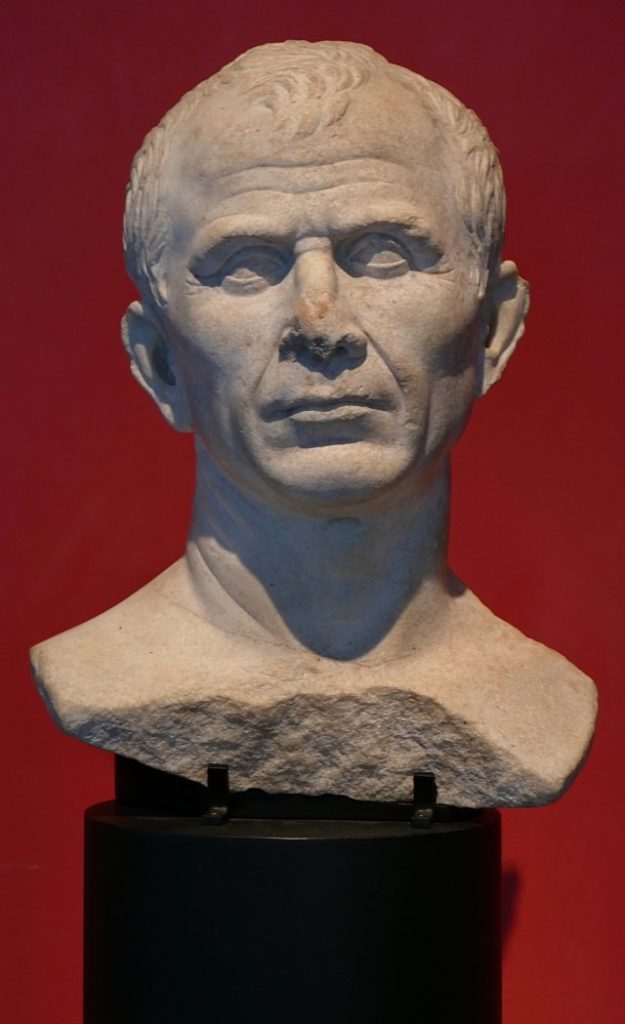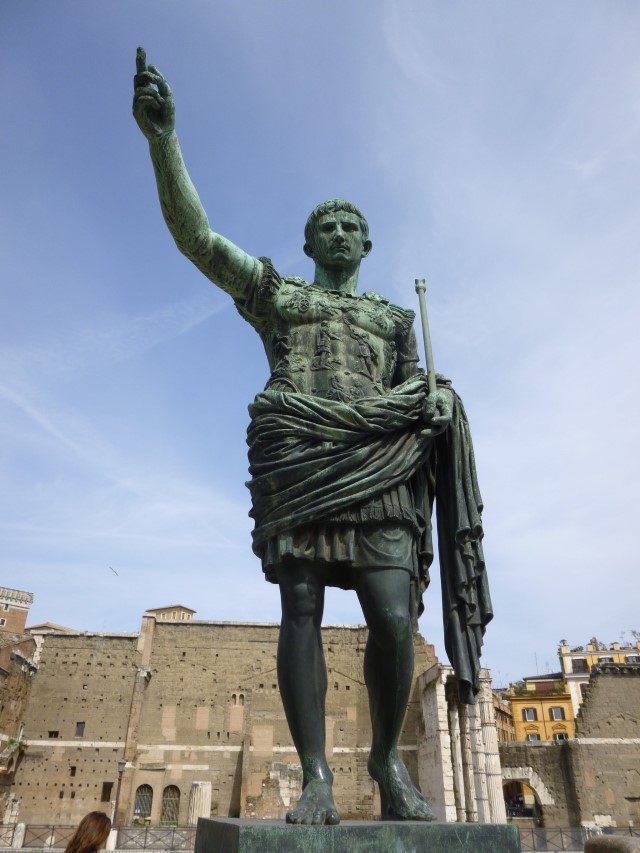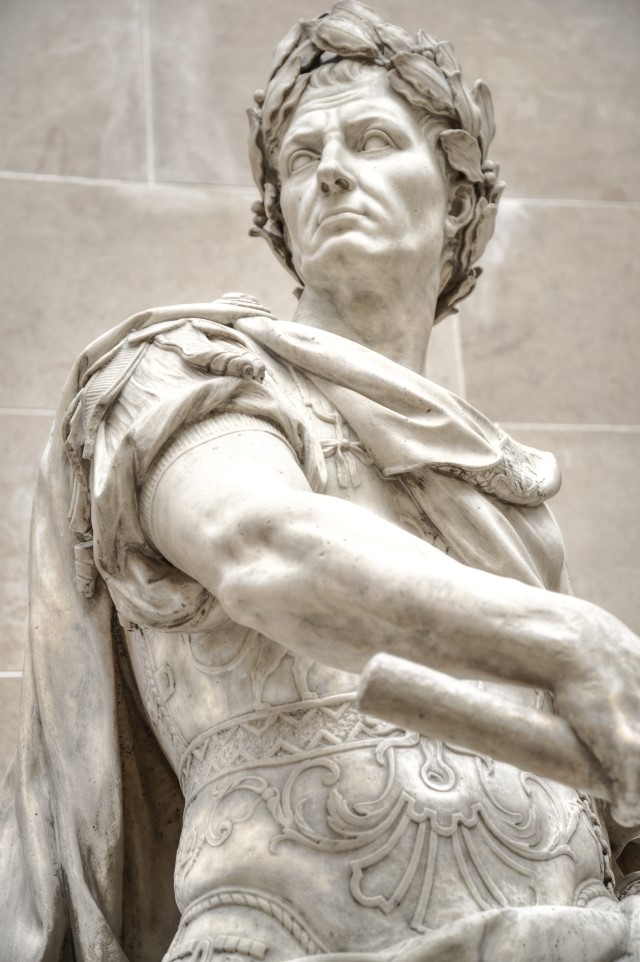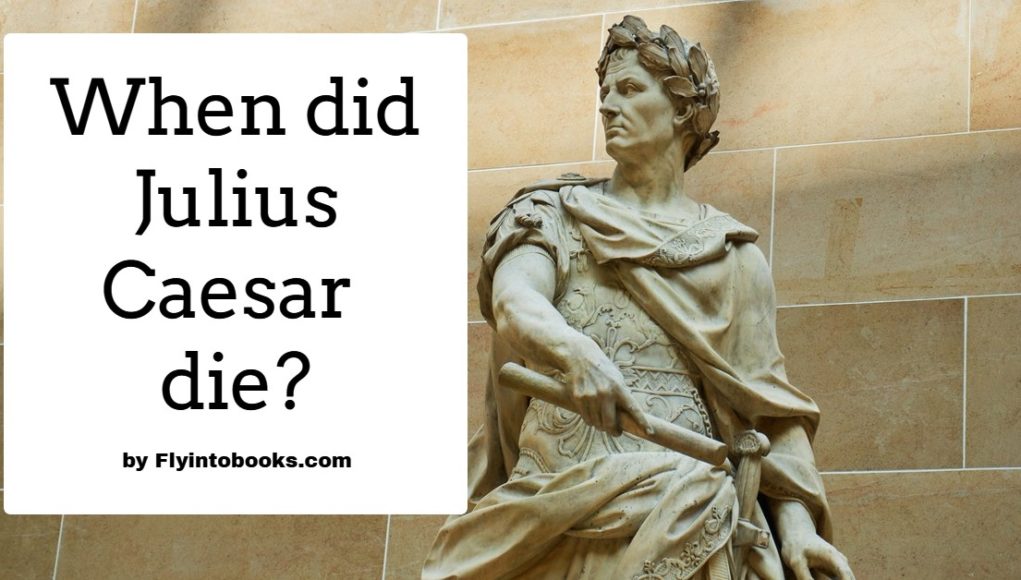Get Ready to Go on a Cultural Journey:
Join Our Newsletter and Discover Fascinating Destinations and Literary Adventures That Will Ignite Your Imagination!
Affiliate Disclosure: As an Amazon Associate, I earn from qualifying purchases. If you choose to purchase after clicking a link, I may receive a commission at no extra cost to you.
When did Julius Caesar Die? All your Burning Questions Answered!
Here, I will explain how Julius Caesar died and when Julius Caesar died. There might be a few tidbits of history, especially about the Ancient Roman calendar, that you will need to know so that you can fully understand the answers to these questions.
Fortunately, I have done all the research for you and have referenced appropriate historical sources which you can look at if you want to delve deeper into this topic.
This Ultimate Guide to Julius Caesar includes:
When Did Julius Caesar Die?
When did Julius Caesar die? Many people and internet sites state that Julius Caesar died on the 15th of March, 44 BC. But did Julius Caesar really die on the 15th of March?
Well, yes and no.
If we look at the historical sources, like Plutarch’s Lives of the Noble Greeks and Romans (or in short Parallel Lives), they don’t actually state that Julius Caesar died on the 15th of March. Instead, they use the term ‘the Ides of March’.

From Plutarch’s Lives of the Noble Greeks and Romans (emphasis mine):
A certain seer warned Caesar to be on his guard against a great peril on the day of the month of March which the Romans call the Ides.
So, what date is the Ides of March? From our modern point of view, it is the 15th of March. But the Ancient Romans are not us. We shouldn’t change the truth of the past by converting everything into our modern experiences.
Instead, it is important to first look at the world of the Ancient Romans from their own point of view. Only after that, can we interpret what happened in the past through our own modern lens.
As McCullagh states in his book The Truth of History:
Historians should present past ideas in their own terms first, being very careful to conserve the truth, but then reflect upon them from a modern point of view.
So, in order to understand what the Ides of March is in terms of the viewpoint of the Ancient Romans, we need to look at how the Ancient Romans viewed the dates of months.
What was the Ancient Roman Calendar?
The earliest Roman calendar originated as a local calendar in the city of Rome. It consisted of only 10 months – 6 months of 30 days and 4 months of 31 days. The names of the 10 months were Martius, Aprilis, Maius, Junius, Quintilis, Sextilis, September, October, November, December.
The name of Quintilis comes from Latin (meaning the ‘fifth month’). The name of Sextilis similarly comes from Latin (meaning the ‘sixth month’). So too for the other months from September (from Latin septem meaning ‘seven’) to December (from Latin decem meaning ‘ten’ ). These last 6 months in the original ten-month Roman calendar all came from Latin numbers.
From Plutarch’s The Life of Numa:
They still call it December, or the tenth month. And that March used to be their first month, is proved by the sequence of months after it; for the fifth month after it used to be called Quintilis, the sixth Sextilis, and so on with the rest.

(Italian: Fontana di Trevi)
The calendar began in Martius (March) in Spring, ended in December at the end of Autumn/Fall, and totalled just 304 days. After December ended there was an unnamed and unnumbered winter gap, with the Ancient Romans largely ignoring these 61 winter days.
Calendar of Romulus: (753 BCE)
- Martius (Month of Mars): 31 days
- Aprilis (Month of Aphrodite): 30 days
- Maius (Month of Maia): 31 days
- Junius (Month of Juno): 30 days
- Quintilis (Fifth Month): 31 days
- Sextilis (Sixth Month): 30 days
- September (Seventh Month): 30 days
- October (Eighth Month): 31 days
- November (Ninth Month): 30 days
- December (Tenth Month): 30 days
Romulus (one of the two mythological twin brothers who founded the city of Rome) supposedly drew up this early Roman calendar seven or eight centuries before the Christian era / Common Era (800 – 700 B.C./B.C.E.). Romulus borrowed parts of the ancient Greek calendar system to build the structure of this early Roman calendar.
The Addition of January and February into the Ancient Roman Calendar
In order to account for the winter days, Numa Pompilius (715?–673? BCE) added in the months of Ianuarius (January) and Februarius (February) to the Roman calendar. According to tradition, Numa Pompilius was Romulus’s successor and the second King of Rome. The addition of these two months made the Roman calendar have 12 months and equal a total of 355 days.

However, the 12 months of this calendar were based on the revolutions of the moon and not on the revolution of the Earth around the Sun. In fact, this 12 month Roman calendar was 101/4 days shorter than a full solar year. A full solar year consists of 365 1/4 days but the 12-month Roman calendar only had 355 days. This meant that over time the calendar would slip out of sync with the seasons. (Imagine if Winter started in August or September and not in January…!)
The Roman Republic Calendar: 713 BCE
- Ianuarius (Month of Janus): 29 days
- Februarius (Month of Februa): 28 days
- Mercedonius (Month of Wages – the Intercalary Month): 27 days
- Martius (Month of Mars): 31 days
- Aprilis (Month of Aphrodite): 29 days
- Maius (Month of Maia): 31 days
- Junius (Month of Juno): 29 days
- Quintilis (Fifth Month): 31 days
- Sextilis (Sixth Month): 29 days
- September (Seventh Month): 29 days
- October (Eighth Month): 31 days
- November (Ninth Month): 29 days
- December (Tenth Month): 29 days
Therefore, according to Livy, Numa also inserted an intercalary month called Intercalans or Mercendonius between February 23 and 24. This intercalary month consisted of 27 or 28 days and was added every two years. When this intercalary month was inserted, the remaining 5 days of February were omitted (at least in ancient times).
(Want to know more about the Ancient Romans? Check out the Great Books of the Western World).
With the insertion of the intercalary month every two years, the average length of the Roman calendar was 366.25 days per year. However, there were still some problems with this system.
Why did Julius Caesar invent the Julian Calendar?
Julius Caesar invented the Julian Calendar because there were problems relating to the insertion of the intercalary month into the calendar. The insertion of the intercalary month helped align the Ancient Roman calendar with the seasons by making the average length of the Roman calendar 366.25 days per year. Moreover, the Julian Calendar was not an entirely new invention but merely a revision of previous Ancient Roman calendars (see above).
Before Julius Caesar’s changes to the calendar, adding the intercalary month every second year was the job of the College of Pontiffs and the Pontifex Maximus. The College of Pontiffs was a council of priests in Ancient Rome and the Pontifex Maximus was the chief high priest of the College of Pontiffs. Their main jobs in Ancient Rome were to advise the Roman Senate about issues relating to the gods, supervise the calendar, and thus supervise the religious ceremonies & specific rituals on special days.

In effect, by managing the calendar the College of Pontiffs determined the days which religious and political meetings could be held, when sacrifices could be offer, when votes could be cast, and when senatorial decisions could be brought forth. Which meant that the intercalary month was used for political purposes, not just to align the calendar with the seasons. In fact, there were many problems with the Intercalary month…
What were the problems with the Intercalary Month?
The problems with the intercalary month were that the Pontifex Maximus and College of Pontiffs didn’t always insert it into the calendar every two years. This was because intercalation (insertion of the extra month) was considered unlucky. Also, the calendar was manipulated for the benefit of certain political leaders and vested interests rather than merely for the alignment of the calendar with the seasons.
For example, the tenure of an officeholder could be extended or reduced and legislation given more or less time for a vote depending on the actions of the Pontifex Maximus and the College of Pontiffs. In fact, Biblius (Julius Caesar’s co-consul in 59 B.C.E.) attempted to thwart Julius Caesar’s proposed legislation by declaring all the remaining days of the year to be holidays. This meant that the Senate could not meet to discuss or vote on Julius Caesar’s proposed legislation until the start of the new year.
In effect, by the time Julius Caesar came into power, the calendar was considerably out of sync with the seasons because of the neglect or corruption of the College of Pontiffs. When Julius Caesar returned to Rome from Egypt in 46B.C.E. and was declared dictator, a three-month discrepancy existed between the seasons and their calendar date.

This caused Suetonius (a Roman Historian who wrote on the lives of the twelve Caesars) to complain that the harvest was being celebrated even before the crops had even been taken in.
As Suetonius states in his book The Lives of the Caesars:
The harvest festivals did not come in summer nor those of the vintage in the autumn.
What is the Julian Calendar?
To see when Julius Caesar died, we need to look at the Julian Calendar. The Julian Calendar was a reform of the Roman Republic calendar. In 46 BCE, Julius Caesar ordered a reform of the Republic Calendar after his victory in the Roman civil war (between himself and Pompey). He ordered the reform of the calendar because there were many problems with the Republic Calendar, especially concerning the insertion of the intercalary month (see above).
The reform was undertaken by a group of scholars which included Sosigenes of Alexandria and M. Flavius of Rome.
(What are the best Historical Videos? Check out our list here).
The new Julian Calendar added 10 days to a regular pre-Julian Calendar year of 355 days. This meant that a regular Julian year consisted of 365 days.
Two extra days were added to Ianuarius, Sextilius, and December. One extra day was added to Aprilis, Junius, September and November. Februarius was not changed and continued to have 28 days. Thus, the Julian reform gave us the length of days in each month as we have today.
The Julian Calendar: 45 BCE
- Ianuarius (Month of Janus): 31 days
- Februarius (Month of Februa): 28 days
- Martius (Month of Mars): 31 days
- Aprilis (Month of Aphrodite): 30 days
- Maius (Month of Maia): 31 days
- Junius (Month of Juno): 30 days
- Quintilis (Fifth Month): 31 days
- Sextilis (Sixth Month): 31 days
- September (Seventh Month): 30 days
- October (Eighth Month): 31 days
- November (Ninth Month): 30 days
- December (Tenth Month): 31 days
Why do we have a leap year every four years?
Julius Caesar abolished the old intercalary month of Mercedonius as it was no longer needed after he reformed the Republic calendar. Instead, a single leap day was added every fourth year in order to bring the Roman calendar into close agreement with the solar year (the time it takes for the Earth to revolve around the sun).
Thus, a regular Julian year consisted of 365 days but a leap year consisted of 366 days. So, on average, the Julian year was 365.25 days long.
However, this still meant the Julian year drifted over time with respect to the solar (tropical) year. A solar year is 365.24217 days long, but a Julian year was on average 365.25 days long. In other words, the Julian Calendar had an error of 1 extra day every 128 years. The Gregorian calendar attempted to fix this error (more on that below).

(One of the most famous fountains in the world)
But, adding a single intercalary day every four years had a lot of benefits compared to the problems associated with inserting an intercalary month in pre-Julian calendars. Some of these benefits include: stopping priests from using the addition of the intercalary month for political reasons and having fixed rules on when to insert the intercalary day.
The year 46BCE was the last year of the pre-Julian calendar. By that time the calendar had shifted significantly with respect to the seasons. So, following the advice of Cleopatra’s court astronomer, Julius Caesar added 67 days (3 intercalary months) for one time only to the year 45 BCE.
(Love history? Why not take a look at the Great Books of the Ancient Greeks!)
The first intercalary month was inserted in February and two more intercalary months (Intercalaris Prior and Intercalaris Posterior) were inserted before the kalends of December.
Julius Caesar’s reform is described by Plutarch of Chaeronea (ca. 45–120 CE) in Chapter 59 of his Life of Julius Caesar:
Caesar, however, put the problem before the best scholars and mathematicians of the day and, out of the various methods of correction already in use he formed a new method of his own which was more accurate than any of them. It is he one still used by the Romans, and it seems that they, better than all other people, have avoided the errors arising from the inequality between the lunar and solar years.
What about the months of July and August?
After Julius Caesar was assassinated on the Ides of March, Mark Antony had Julius Caesar’s birth month Quintilis renamed to Iulius (July) in order to honour him. Mark Antony (or Marcus Antonius in Latin) was a supporter of Julius Caesar and served as one of his generals during the conquest of Gaul and the Civil War.
After Mark Antony’s defeat at the Battle of Actium, Augustus Caesar assumed control of Rome and made further refinements. Augustus renamed the month of Sextilis to Augustus (August) in order to honour himself.

Augustus also found that the priests had been inserting the intercalary day every three years instead of every four years. This might be because the priests made a calculation error due to their inclusive counting (also called a fence-post error). So, Augustus suspended the addition of the intercalary day for a decade or two until its proper position had been corrected.
Calendar of Augustus: 8BCE
- Ianuarius (Month of Janus): 31 days
- Februarius (Month of Februa): 28 days
- Martius (Month of Mars): 31 days
- Aprilis (Month of Aphrodite): 30 days
- Maius (Month of Maia): 31 days
- Junius (Month of Juno): 30 days
- Julius (honoring Julius Caesar): 31 days
- Augustus (honoring Augustus Caesar): 31 days
- September (Seventh Month): 30 days
- October (Eighth Month): 31 days
- November (Ninth Month): 30 days
- December (Tenth Month): 31 days
What is the Ides of March?
When did Julius Caesar die? Julius Caesar was assassinated on the Ides of March, which people usually refer to as the 15th of March. So, what is the Ides of March?
The Ides of March comes from the way the Ancient Romans counted the days of the months. To count the days of the months, the Ancient Romans counted forward towards the next of one of three principal days in each month.
The three principal days were:
- Kalends (Kalendae): the 1st day of each month
- Nones (Nonae): the 7th day of full* months and the 5th day of hollow** months
- Ides (Idus): the 15th day of full* months and the 13th day of hollow** months. That is, one day less than the middle of each month.
*Full months are those months which had 31 days under the pre-Julian calendar (i.e. March, May, July, October)
** Hollow months are those months which had 29 days or 28 days under the pre-Julian calendar (i.e. January, February, April, June, August, September, November, December)
So, the Ides of March does correspond to the 15th of March from our point of view. However, the Ides of April is not the 15th of April but in fact the 13th of April under the Julian calendar.
Why?
This is because March is a full month – in other words, March had 31 days in the pre-Julian calendar so the Ides of March is the 15th of March under the Julian calendar.
But April is a hollow month – in other words, April had 29 days in the Pre-Julian Calendar so the Ides of April is the 13th of April under the Julian calendar.
(What is the best way to learn Latin? Check out our post here!).
Furthermore, Julius Caesar did not change the position of the three principal days (Kalends, Nones, Ides) in a month even after he added extra days to different months during his reform of the Republic calendar. This was because Julius Caesar wanted to avoid affecting the festivals tied to the Nones and Ides of various months.
(However, because the dates at the ends of months all counted forward to the next Kalends they were all shifted by one or two days by the change. This caused confusion in regards to anniversaries.)
This meant that the Ides of January, August, and December were still on the 13th of those respective months, even if they had 31 days after the Julian calendar reforms. This also applied to the Nones of those months too. The Nones of January, August, and December were still on the 5th of those respective months even though they had 31 days after the Julian calendar reforms.
Interesting fact:
The kalends were the day for payment of debts. Account books (Kalendaria) kept for payments gave English its word for calendar.
The days of March, according to the Julian Calendar:
The Ancient Romans during the time of Julius Caesar would count the days of March as follows.
Notice: The Ancient Romans practised inclusive counting, so that Day 5 is the 3rd Day before the Nones, not the 2nd Day before the Nones. To the Ancient Romans, the day before the Nones was the same as the 2nd day before the Nones because they counted the Nones as the first day.
- Day 1: On the Kalends
- Day 2: The 6th Day before the Nones
- Day 3: The 5th Day before the Nones
- Day 4: The 4th Day before the Nones
- Day 5: The 3rd Day before the Nones
- Day 6: The Day before the Nones
- Day 7: On the Nones
- Day 8: The 8th Day before the Ides
- Day 9: The 7th Day before the Ides
- Day 10: The 6th Day before the Ides
- Day 11: The 5th Day before the Ides
- Day 12: The 4th Day before the Ides
- Day 13: The 3rd Day before the Ides
- Day 14: The Day before the Ides
- Day 15: On the Ides
- Day 16: The 17th Day before the Kalends
- Day 17: The 16th Day before the Kalends
- Day 18: The 15th Day before the Kalends
- Day 19: The 14th Day before the Kalends
- Day 20: The 13th Day before the Kalends
- Day 21: The 12th Day before the Kalends
- Day 22: The 11th Day before the Kalends
- Day 23: The 10th Day before the Kalends
- Day 24: The 9th Day before the Kalends
- Day 25: The 8th Day before the Kalends
- Day 26: The 7th Day before the Kalends
- Day 27: The 6th Day before the Kalends
- Day 28: The 5th Day before the Kalends
- Day 29: The 4th Day before the Kalends
- Day 30: The 3rd Day before the Kalends
- Day 31: The Day before the Kalends
Dates after the Ides count forward to the Kalends of the next month and were expressed as such. For example, March 16 was expressed as “the 17th Day before the April Kalends” (a.d. XIV Kal. Apr.) without mentioning March itself.
The days of other months were counted differently depending on whether they were full months or hollow months in the Pre-Julian calendar. See this Wikipedia article for more information.
Why do we follow the Gregorian Calendar and not the Julian Calendar today?
The Romans started following the Julian Calendar in 45BCE. A regular Julian year consisted of 365 days and every fourth year a leap year consisted of 366 days. So, on average, the Julian year was 365.25 days long.
However, this still produced problems because a solar (tropical) year is exactly 365.24217 days long. This meant that the Julian calendar had an error of adding 1 extra day in the calendar every 128 years.
So by the time of Pope Gregory XIII in the 1500s, the extra day per 128-year error within the Julian calendar had amounted to around a 10-day misalignment. This caused the holidays to be noticeably misaligned with the seasons.

So, in order to correct the mistakes caused by the old Julian calendar, Pope Gregory XIII adopted a new calendar which was devised by Aloysius Lilius (a Calabrian who had studied medicine and astronomy in Naples).
This new calendar (called the Gregorian calendar) was decreed by Pope Gregory XIII when he issued a papal bill on 24 February 1582. This bull is named “Inter Gravissimas” after its first two words.
What is the difference between the Julian Calendar and the Gregorian Calendar?
The main difference between the Julian calendar and the Gregorian calendar is the way they add leap years into their calendars.
The Julian Calendar inserted a leap year of 366 days every fourth year, or 100 leap years every 400 years.

(full name: The Papal Basilica of Saint Peter in the Vatican)
In contrast, the Gregorian calendar inserts only 97 leap years every 400 years. (Gregorian leap years are also 366 days long). The Gregorian calendar achieves this by the following calculation:
- Every year divisible by 4 is a leap year, except for years that are divisible by 100.
- But the years that are divisible by 400 will be a leap year.
So, for example, that means:
- the years 2100, 2200 and 2300 won’t be leap years
- but the year 2400 will be a leap year
In other words, the Julian calendar has 100 leap years every 400 years but the Gregorian calendar omits 3 of those 100 leaps years (those divisible by 100 but not 400). Thus, leaving only 97 leap years every 400 years!
That means the Gregorian calendar has an average year of 365.2425 days (or 365 days 5 hours 49 minutes and 12 seconds).
In other words, we use the Gregorian calendar because it is substantially more accurate when compared to the previous Julian calendar. The Gregorian calendar has an error of only 1 extra day every 3,030 years compared to the Julian calendar’s error rate of 1 extra day every 128 years.
How did Julius Caesar die?
Julius Caesar was assassinated on the 15th of March (the Ides of March) in 44B.C. The assassination was perpetrated by a group of Roman senators led by Marcus Brutus, Gaius Cassius and Decimus Brutus Albinus.
On the 15th of March 44B.C. Julius Caesar arrived at Pompey’s theatre for a meeting with the Senate and entered the Curia of Pompey. He sat down in a chair ready to address the hundreds of lawmakers gathered before him.

First, Casca struck at Julius Caesar with a dagger. Caesar was surpised and Casca called for help. The whole group of lawmakers (over 40 people) began stabbing Julius Caesar.
Julius Caesar attempted to escape, but was surrounded by a mob of around 60 men. In the end, Julius Caesar was stabbed 23 times with only one of the wounds being fatal.
So, when did Julius Caesar die? We explain above – check out the table of contents!
Why did Julius Caesar die?
Tensions were running high between Julius Caesar and the Roman Senate in 44B.C. after Julius Caesar was named dictator for life (dictator perpetuo or dictator in perpetuum).
So, what do you think happened?
More about why Julius Caesar died in our next post!
Stay tuned!
Peace!
A.J. McMahon
Let’s connect:
– Instagram: AussieAndyEnglish
– Pinterest: FlyIntoBooks
– Facebook: FlyIntoBooks
– Twitter: @FlyIntoBooks
– GoodReads: A.J. McMahon
Affiliate Disclosure: As an Amazon Associate, I earn from qualifying purchases. If you choose to purchase after clicking a link, I may receive a commission at no extra cost to you.
Get Ready to Go on a Cultural Journey:
Join Our Newsletter and Discover Fascinating Destinations and Literary Adventures That Will Ignite Your Imagination!













